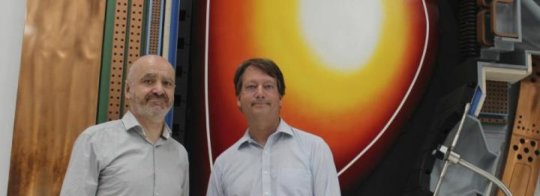[ad_1]
Before scientists can capture and recreate the fusion process that powers the sun and stars to produce virtually limitless energy on Earth, they must first learn to control the hot plasma gas that fuels fusion reactions. In a set of recent experiments, scientists have tamed a plasma instability in a way that could lead to the efficient and steady state operation of ITER, the international experiment under construction in France to demonstrate the feasibility of fusion power. Such continuous operation will be essential for future fusion devices.
Fusion powers the sun and stars by fusing light elements in the form of plasma — the hot, charged state of matter composed of free electrons and atomic nuclei — to produce massive amounts of energy. Scientists are seeking to replicate fusion on Earth for a virtually inexhaustible supply of electricity-generating power.
The most recent findings, developed by a team of researchers led by physicist Raffi Nazikian of the U.S. Department of Energy’s (DOE) Princeton Plasma Physics Laboratory (PPPL) and Craig Petty of General Atomics, stem from experiments conducted on the DIII-D National Fusion Facility operated by General Atomics for the DOE in San Diego. The results build on earlier work led by DIII-D scientists that demonstrated the conditions needed for steady-state operation of the core of ITER plasmas and established techniques to control these plasma instabilities.
The new research targets instabilities called Edge Localized Modes (ELMs) that develop at the periphery of fusion plasmas. Such instabilities can cause periodic heat bursts that can damage plasma-facing components in a tokamak. “In these results we observe the suppression of large ELMs, leaving small benign ELMs in plasmas that overlap with the conditions required for steady-state ITER operation,” said Nazikian, lead author of a scientific paper in IAEA’s Nuclear Fusion journal that lays out the findings. “These new experiments are a great example of successfully combining two separate advances, in this case 100 percent current drive in the plasma core and large ELM suppression in the edge, in an efficient and effective manner” said Petty, lead author of a prior Nuclear Fusion paper on the DIII-D findings relevant to the steady state core of the ITER plasma.
To keep large ELMs from occurring, researchers produce small magnetic ripples known as resonant magnetic perturbations (RMPs) that distort the smooth doughnut shape of tokamak plasmas. In the recent experiments, the scientists found that increasing the overall pressure of the plasma makes the plasma far more responsive to the ripples to better control ELMs and produce the conditions needed for steady-state ITER operation.
The higher pressure also increases a self-generated current that forms inside tokamak plasmas. This can be combined with particle beams and microwaves to drive and sustain the plasma current indefinitely in a so-called steady state. These higher self-generated currents make this process more efficient, and thus a fusion power plant more attractive.
When researchers projected the recent DIII-D results to ITER, they found that the higher plasma pressure and bootstrap current, together with additional sources of current from particle beams and microwaves, could create a fully sustainable steady-state regime that generates four-to-five times more power than it will take to heat the plasma and drive the current. Support for this work comes from the DOE Office of Science (FES) and the General Atomics Postdoctoral Research Participation Program administered by Oak Ridge Associated Universities (ORAU).
Going forward, physicists seek to create a greater percentage of bootstrap current to increase the fusion power gain and reduce the additional power needed to drive current. These DIII-D experiments produced about 30 percent self-driven current, although the bootstrap current fraction are projected to increase in ITER as its higher field means its ions collide less often, enabling current to be driven more easily.
“What we are currently working on in DIII-D is to develop the basis for fully steady-state high pressure plasma for ITER and beyond,” Nazikian said. “A central goal of the DIII-D program now is to identify ways in which high-pressure plasmas can drive most of the current required for steady-state reactors. We are undertaking major upgrades to the facility to meet this goal while exploring regimes that are free of dangerous ELMs.”
Story Source:
Materials provided by DOE/Princeton Plasma Physics Laboratory. Note: Content may be edited for style and length.
[ad_2]















